Earth and Universe Chapter Notes | Science Olympiad for Class 2 PDF Download
| Table of contents |

|
| Earth and Universe |

|
| Our Solar System |

|
| Phases of the Moon |

|
| Earth and Its Landscape |

|
Earth and Universe
The universe is a huge space filled with amazing things like stars, planets, and moons. Some of these things can be seen by us. During the daytime, we see the sun shining bright, and at nighttime, we can see the moon and the sparkling stars in the sky.
Our Solar System
Our solar system is like a family of planets, each with its own unique features. It includes the Sun, eight planets, their moons, comets, asteroids, meteors, and even some dwarf planets.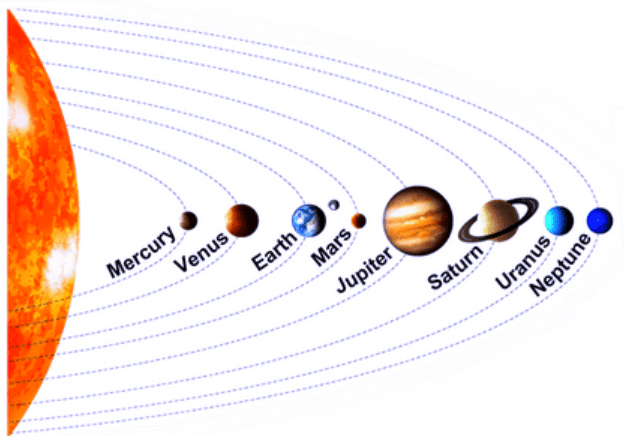
The Planets
A planet is a round object that moves around the Sun in a special path called an orbit.
- There are eight planets in our solar system. They are Mercury, Venus, Earth, Mars, Jupiter, Saturn, Uranus, and Neptune.
- Mercury is the smallest planet in our solar system, while Jupiter is the biggest planet.
- Venus is the hottest planet while Uranus is the coldest planet.
- Mars is often called the red planet because it has a reddish colour.
- Earth is the only planet we know of that supports life. That's why it's sometimes called the blue planet because of all the beautiful blue oceans and seas.
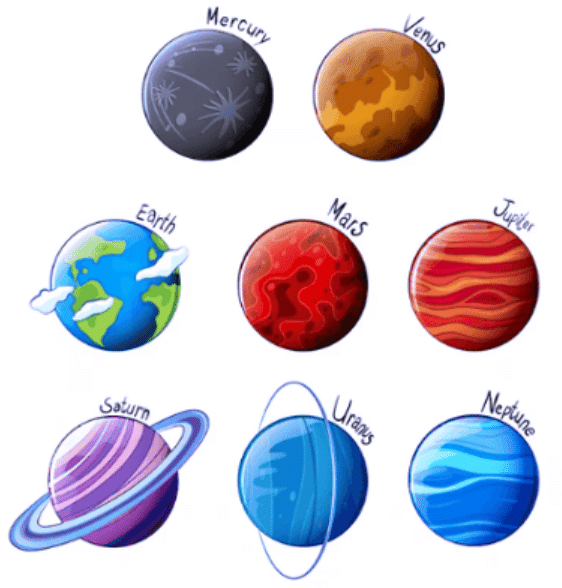
Sun
- The sun is like a big shining star that gives us heat and light. It's a huge ball made of hot gases.
- During the day, the sun makes our surroundings warm and bright. But at night, when the sun is not there, it becomes cool and dark.
- The sun is very important for life on Earth. Without the sun, there would be no life on our planet.
- We can see the sun rising in the east and setting in the west, creating beautiful sunrises and sunsets.
Moon
- The moon is a special companion to our Earth. It's the only natural satellite that orbits around our planet.
- The moon is much smaller than Earth.
- Unlike the sun, the moon doesn't have its own light. It reflects the light from the sun, which is why we see it glowing at night.
- The moon is made up of dust and rocks.
- It's a fascinating place, but there is no air or water on the moon, so it cannot support life.
Stars
- When we look up at the night sky, we see thousands of twinkling lights called stars.
- Stars are like faraway suns that look tiny because they are so distant from us.
- Some stars are even bigger than our own sun.
Constellations
- Sometimes, groups of stars appear to form patterns in the sky. These patterns are called constellations.
- There are 88 constellations that have been named after creatures and characters from myths and legends.
- Some famous constellations include Leo, Ursa Major (the Big Dipper), and Orion.
- They help us navigate the night sky and tell stories of ancient times.

Phases of the Moon
The moon takes about 28 days to go all the way around the Earth. As it moves, we see different shapes of the moon in the sky every night. These different shapes are called the phases of the moon.
- Full moon: This is when the moon looks like a big round ball in the sky.
- Half moon: Sometimes, we see the moon as a half-circle shape in the sky. One side is bright, and the other side is dark.
- Crescent moon: When the moon looks like a curved shape, like a banana or a smile, we call it a crescent moon.
- New moon: This is a special phase when we can't see the moon at all. It’s because the side of the moon facing us doesn't have any sunlight on it.
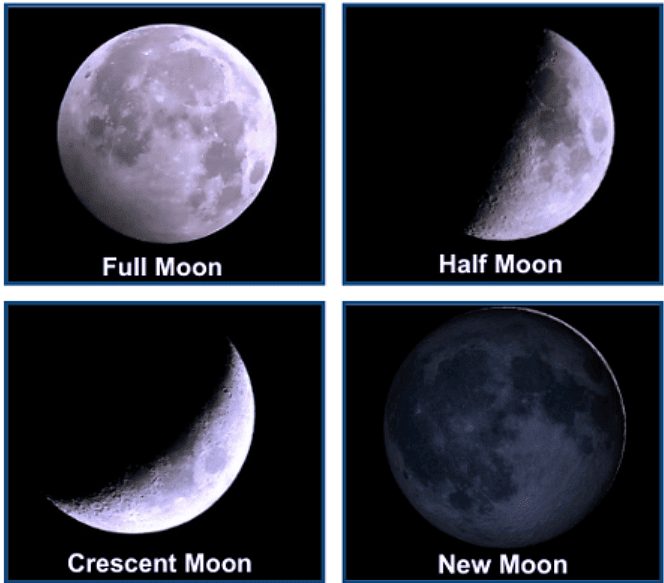
Earth and Its Landscape
When we look at Earth from space, it looks blue, which is why we call it the blue planet. It's special because it's the only planet in our solar system where life exists. About three-fourths of Earth is covered with water.
Landforms
Earth's surface is not the same everywhere. It has different features, which we call landforms. There are different types of landforms:
- Hills: Some places have land that is naturally raised compared to the surrounding area. We call these places hills. Hills are higher than plains, and they usually have a pointed and rocky top.
- Mountains: A mountain is a piece of land that is even higher than the surrounding land. It's taller and steeper than a hill.
- The highest mountain peak in the world is Mount Everest.
- Valleys: Valleys are lowlands found between hills or mountains. They can have a V or U shape. Often, rivers or streams flow through valleys.
- The land in a valley is fertile, which means it's good for growing crops.
- Plains: Plains are large areas of flat land. Many cities and villages are built on plains because they are easy to live on.
- Plains are great for growing crops, building houses, and making roads.
- Islands: An island is a piece of land that is surrounded by water on all sides. It's like a little piece of land in the middle of the sea or an ocean.
- Plateaus: A plateau is a highland that has a flat top. It's also known as a tableland because it looks like a table.
- Plateaus are usually rocky.
- Deserts: Deserts are large areas of land that are very dry and covered with sand.
- They receive very little rainfall, so you'll find very few plants and animals living there.
- Forests: Forests are large areas of land that are completely covered with trees. They are home to many animals, birds, and insects.
Forests are important for our planet because they help produce oxygen and provide habitats for different species.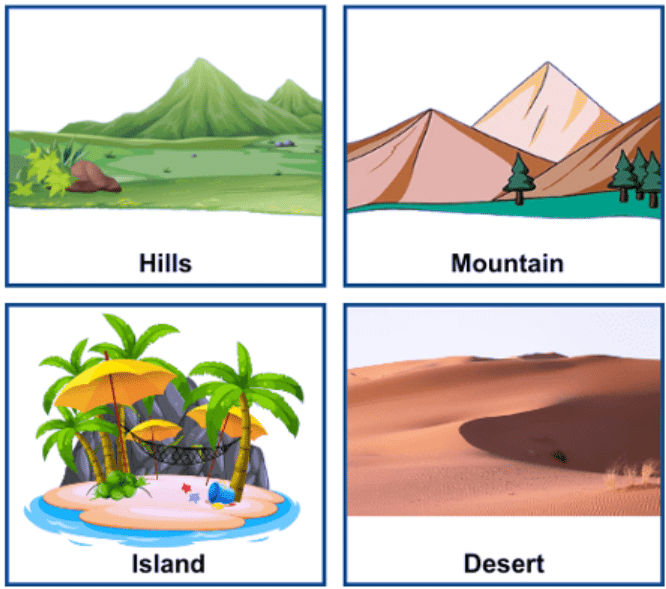
Day and Night
- When we see the Sun coming up in the morning from the east, it means it's the start of the day.
- And when we watch the Sun going down in the evening towards the west, it means it's getting dark and it's time for the night to begin.

Rotation
- Imagine Earth as a spinning top. It spins around an imaginary line called the axis. This spinning motion is called rotation.
- As Earth rotates, one part of it faces the sun and that part experiences daytime. The other part that is away from the sun experiences nighttime.
- It takes Earth about 24 hours to complete one full rotation.
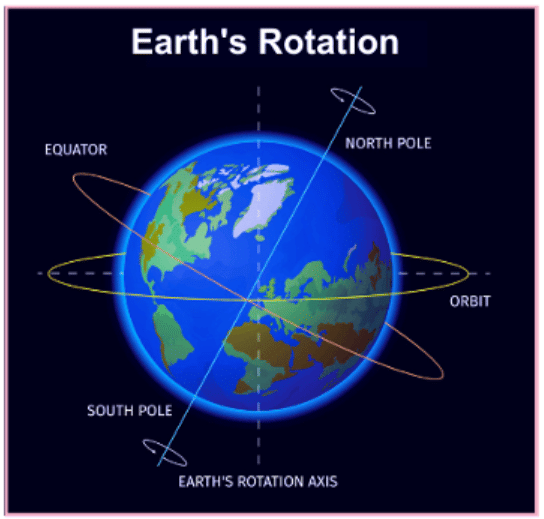
Revolution
- When the Earth moves around the Sun in a specific path, it's called a revolution.
- This path is called an orbit.
- It takes about 365 and a quarter days for the Earth to complete one full revolution around the Sun.
- During this journey, different parts of the Earth receive different amounts of heat and light, which is why we have seasons.
- When a part of the Earth gets more heat and light, it's summer there. And when it gets less heat and light, it's winter. So, as the Earth revolves around the Sun, the seasons change.
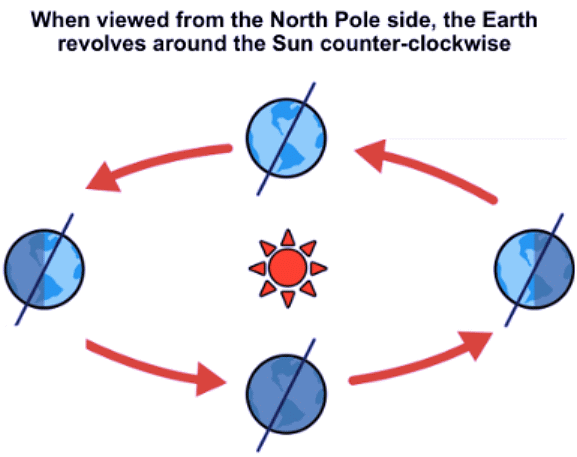
Comets
- Comets are like big groups of rocks and metals.
- They have a special coating of ice and gases.
- When they come close to the Sun, the ice melts and releases gases, creating a glowing tail.
Meteors
- Meteors, sometimes called "shooting stars," are common sights in the sky. They are bright streaks of light that flash for a moment.
- Meteor trails only last for a very short time, less than a second.
- When meteorites hit the Earth, they can create craters.
Asteroids
- Asteroids are large chunks of rocks that orbit around the Sun, mostly found between the planets Mars and Jupiter.
- They are smaller than planets and made of rock. Some people also call them minor planets or planetoids.
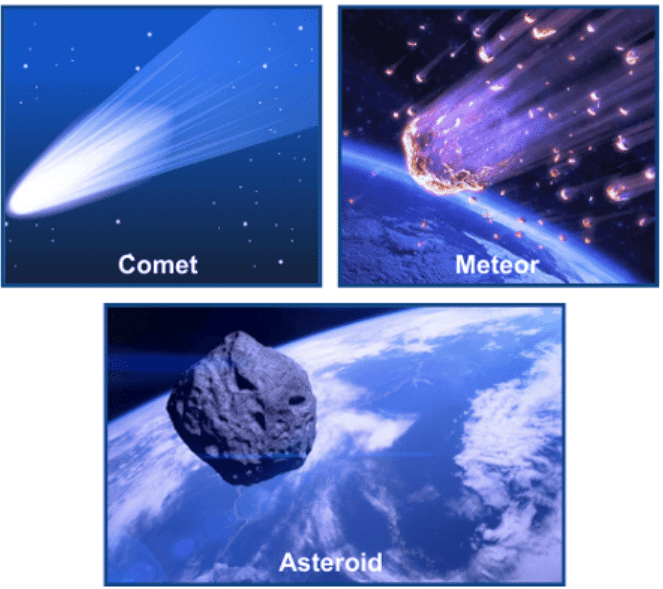
|
40 videos|50 docs|63 tests
|
FAQs on Earth and Universe Chapter Notes - Science Olympiad for Class 2
| 1. What is the difference between the Earth and the Universe? |  |
| 2. How many planets are there in our Solar System? |  |
| 3. What causes the phases of the Moon? |  |
| 4. How does the landscape of the Earth change over time? |  |
| 5. How old is the Earth and Universe? |  |




















